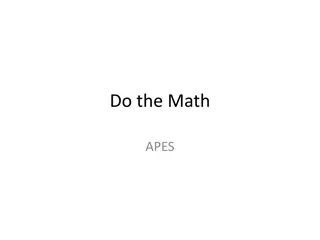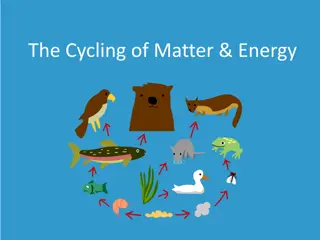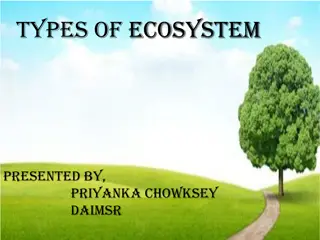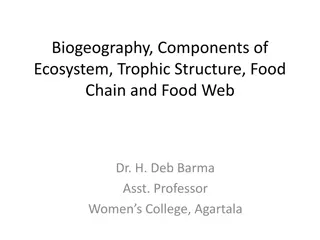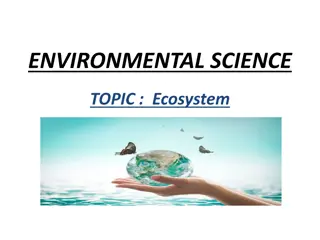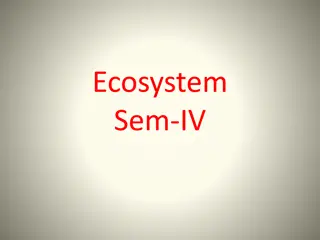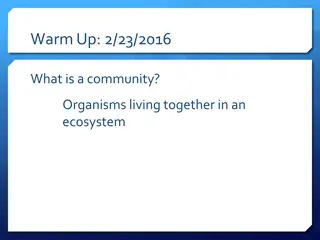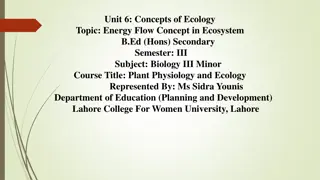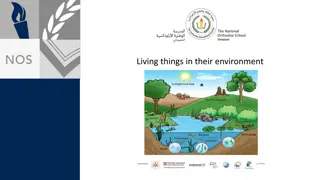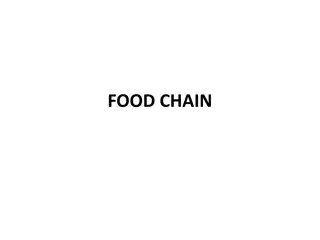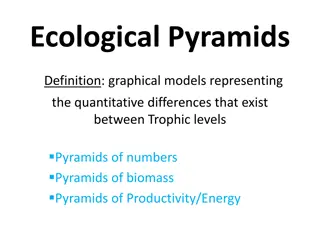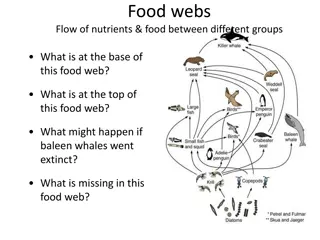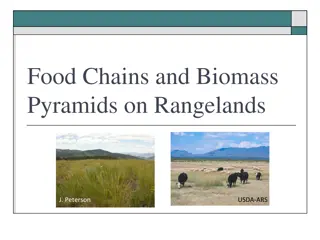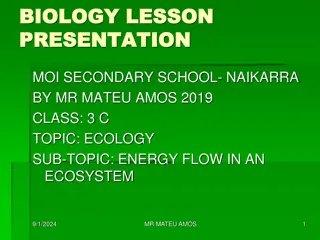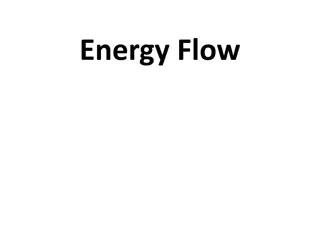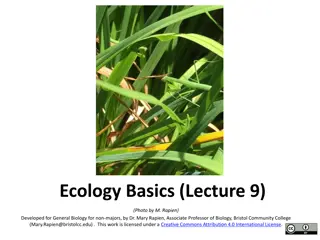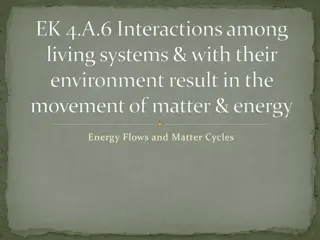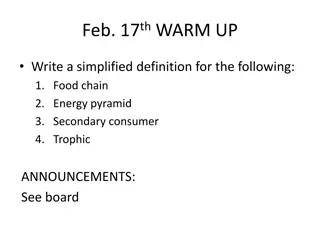Exploring Trophic Levels and Energy Flow in Ecosystems
Understanding trophic levels and energy flow in ecosystems is vital for comprehending the intricate relationships between producers, consumers, and decomposers. Energy enters the food web through producers, transferring from one trophic level to another. Explore the dynamics of Mono Lake ecosystem and trace the movement of energy through different organisms to decomposers and the environment.
Download Presentation

Please find below an Image/Link to download the presentation.
The content on the website is provided AS IS for your information and personal use only. It may not be sold, licensed, or shared on other websites without obtaining consent from the author.If you encounter any issues during the download, it is possible that the publisher has removed the file from their server.
You are allowed to download the files provided on this website for personal or commercial use, subject to the condition that they are used lawfully. All files are the property of their respective owners.
The content on the website is provided AS IS for your information and personal use only. It may not be sold, licensed, or shared on other websites without obtaining consent from the author.
E N D
Presentation Transcript
Warm up Define producers, consumers and decomposers. Organisms that make their own food are producers. Organisms that eat other organisms are called consumers. Dead organisms are broken down and consumed by microorganisms called decomposers.
Review What is food? Energy rich substances like starch and sugar. Where is food made? In producer organisms that engage in photosynthesis like plants and algae. Where is food used in the food web? Every organism uses food including producers, consumers and decomposers. What is the point of consuming food? To obtain the energy needed for life.
Mono Lake Revisit your webs with your groups again. Lay your cards out with producers at the bottom, the primary consumers, etc.
Questions/Mono Lake How does energy enter the Mono Lake ecosystem? Sunlight captured by the algae during photosynthesis. How else? (This one is tricky!) Migratory birds. Do migratory birds bring in energy or do they take it out? They have more mass when they leave, so they take it out. Algae manufacture food. What happens to the food made by the algae? Some is used by the algae, some by the primary consumers that eat the algae, the rest is used by decomposers. What happens to the energy eaten by the brine shrimp? Some is used by the shrimp, some by the consumers that eat them, some to decomposers. (Waste and dead shrimp.)
Trophic Levels The levels in a food web are called trophic levels. Energy enters the food web in the form of sugars and other energy rich chemicals made by producers. When primary consumers eat the producers the energy is transferred to the next trophic level. And so on The names we have been using for roles in the ecosystem are the names of the trophic levels. As you move from producers up through the consumers, each trophic level gets farther away from the origional source, which is usually light from the Sun.
Energy Levels Look at your web. Take a few minutes to trace the movement of energy through the trophic levels in your web. Energy should start at the Sun, transfer to food in one of the producers, move from organism to organism through the trophic levels and end up at decomposers where it passes to the environment. A short energy path might be: Sun- planktonic algae- decomposer-environment. A long path might be: Sun-benthic algae-brine fly-snowy plover-California gull-coyote-decomposer-environment.
Energy Transfer Question Is all the energy consumed by a primary consumer, such as a brine shrimp, transferred to the secondary consumer, like a gull, when the brine shrimp is eaten? Example: A brine shrimp eats 10 g of algae in it s life before the gull eats it, does the gull get 10 g of food energy when it eats the brine shrimp? Discuss with a partner next to you. Think of this question as we read Tropic Levels.
Read Page 20: Energy Transfer What is the basic idea of this section? Most of the energy that is consumed at one trophic level is NOT incorporated into new biomass at that trophic level. Most of the food consumed is used by the organisms to run the machinery of life. Things like digesting food, moving, pumping blood, producing offspring, etc . Only about 10% of the energy consumed at a trophic level is incorporated into the body tissue or offspring at the level. Only 10% of the food energy consumed at one trophic level is available for food for the next level. Write this information in your journal.
10% Idea We have not considered this rule when looking at Mono Lake. Based on the 10% rule, could you have an ecosystem in which there lived 100 kg of algae, 100 kg of brine shrimp, and 100 kg of California gulls? No
Make a Food Chain In your journal, make one Mono Lake food chain, (not the whole web) showing the use of food (energy) and the production of biomass a each level. Use the picture on page 19 as a model.
Biomass Models I have cups with colored beads. Each bead represents 1 kg of biomass in Mono Lake. (One bead is not one organism.) Different colors represent different organisms. We can use these beads to make a physical representation of the trohpic levels in Mono Lake.
What Color? Dark Green: Benthic algae Light Green: Planktonicalgae Red: Brine shrimp Black: Brine flies Gray: California gulls
Try It One red bead represents? 1 kg of brine shrimp. What are brine shrimp going to eat? Planktonicalgae. Using the 10% rule, you need to now put enough algae on your pipe cleaner to feed your 1 kg of shrimp. Lets see them? Did you get it right? How many beads did you put on? 10! That represents the 10 kg of algae biomass that your brine shrimp consumed to produce your 1 kg brine shrimp biomass. 10%...remember?
Challenge Construct 1 kg of gull biomass. What do California gulls eat? Brine shimpand brine flies. Can you show how much biomass went into producing a kg of California gull biomass with the beads in your cup? You will need to show not only the gull biomass, and the food they eat (brine flies and shrimp) but the algae (both kinds) the brine shrimp and flies eat as well.
Wrap Up: Does a healthy ecosystem produce the same amount of biomass at each level? No If the amount of biomass varies, which trophic level has the most biomass? Why? The greatest biomass has to be in the producers. They are the foundation of the food web. The more producers, the more primary consumers, etc.
Wrap Up: If brine shrimp eat 10 kg of algae to produce 1 kg of brine shrimp biomass, where does the other 9 kg of biomass go? Biomass is consumed for energy to run the processes of life. 90% is converted into energy, simple chemicals (carbon dioxide and water) and waste. What happens to an ecosystem if one population fails? Populations at trophic levels higher than the failure might experience stress or failure due to lack of food. Populations at lower trophic levels might thrive if there are less predators.



